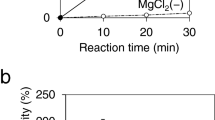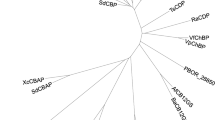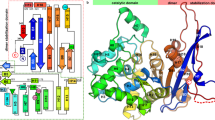Abstract
AN enzyme system catalysing the synthesis of glucosamine-6-phosphate from glutamine and fructose-6-phosphate or glucose-6-phosphate has been demonstrated in Neurospora crassa 1,3, rat liver2,3 and Escherichia coli 3. Ghosh et al. 3, who purified the enzyme from these various sources and studied its properties, have called it L-glutamine-D-fructose-6-phosphate transamidase. We have determined transamidase activity in fresh, cell-free extracts of Bacillus cereus, Micrococcus lysodeikticus, Aerobacter aerogenes and Escherichia coli. Results indicate that, for a given weight of cells, activity is higher in Gram-positive than in Gram-negative bacteria, and for a given organism, activity increases markedly during the lag and early exponential phases of growth, but decreases during the stationary phase. The high transamidase activity associated with dividing cells is probably related to the synthesis of cell-wall basal structure4, which contains amino-sugars. During these investigations, using a system with standard conditions of pH, substrate concentrations and reaction time at 37°, it was found that the amount of glucos-amine-6-phosphate synthesized rarely exceeded 25 per cent theoretical, and frequently was not proportional to enzyme concentration when different volumes of the same cell extract were tested in parallel. An attempt was made to explain these findings.
This is a preview of subscription content, access via your institution
Access options
Subscribe to this journal
Receive 51 print issues and online access
$199.00 per year
only $3.90 per issue
Buy this article
- Purchase on Springer Link
- Instant access to full article PDF
Prices may be subject to local taxes which are calculated during checkout
Similar content being viewed by others
References
Leloir, L. F., and Cardini, C. E., Biochim. Biophys. Acta, 12, 15 (1953).
Pogell, B. M., and Gryder, R. M., J. Biol. Chem., 228, 701 (1957).
Ghosh, S., Blumenthal, H. J., Davidson, E., and Roseman, S., J. Biol. Chem., 235, 1265 (1960).
Work, E., Nature, 179, 841 (1957).
Mickle, H., J. Roy. Micro. Soc., 68, 10 (1948).
Hughes, D. E., Brit. J. Exp. Path., 32, 97 (1951).
Rondle, C. J. M., and Morgan, W. T. J., Biochem. J., 61, 586 (1955).
Strange, R. E., Nature, 187, 38 (1960).
Comb, D. G., and Roseman, S., J. Biol. Chem., 232, 807 (1958).
Author information
Authors and Affiliations
Rights and permissions
About this article
Cite this article
STRANGE, R., DARK, F. Hexosamine Synthesis by Cell-free Extracts of Various Bacteria. Nature 188, 741–742 (1960). https://doi.org/10.1038/188741a0
Issue Date:
DOI: https://doi.org/10.1038/188741a0
Comments
By submitting a comment you agree to abide by our Terms and Community Guidelines. If you find something abusive or that does not comply with our terms or guidelines please flag it as inappropriate.



